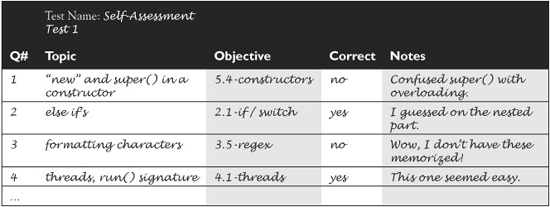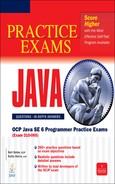Creating Your Exam Log
The more you can pinpoint your weaknesses, the more focused and efficient your studies will be. We recommend you create a written log for each of the exams in this book, and for any other practice exams you take. Once you’ve taken a practice exam and scored it, go back through the exam and make a log. We like the rough format shown in Table 1-2, but you should modify it to suit your learning style. Note that we filled in several example rows to illustrate how you might fill in your logs.
Table 1-2 is an example of what a partial exam log might look like after you’ve filled it in. The more honest you are with yourself, the more useful these logs will be. For example, if you guessed on a question, even a little bit, it will be helpful to you to acknowledge that guess in your log. Another way to be honest with yourself is to reflect on whether you knew a certain topic thoroughly, or whether the question just happened to hit on your strong point.

TABLE 1-2 Sample Exam Log
In addition, it will help you to fill out ALL the columns in the log. The very act of thinking through them and then writing down your own summary of each question will be a great learning exercise. Be precise with your terms! Here are some examples:
![]() Are you referring to an instance of a class or a class?
Are you referring to an instance of a class or a class?
![]() Call them reference variables, not pointers.
Call them reference variables, not pointers.
![]() Think in terms of a method’s “signature.”
Think in terms of a method’s “signature.”
![]() Call them “chained constructors.”
Call them “chained constructors.”
![]() Use the phrase “handle or declare,” and so on.
Use the phrase “handle or declare,” and so on.
The most successful OCP Java SE 6 Programmer candidates we’ve seen take the time to learn the phrases and terms that experienced Java programmers use. When you find yourself thinking in terms of that vernacular, know that you’re in good company—so fill out your logs.
